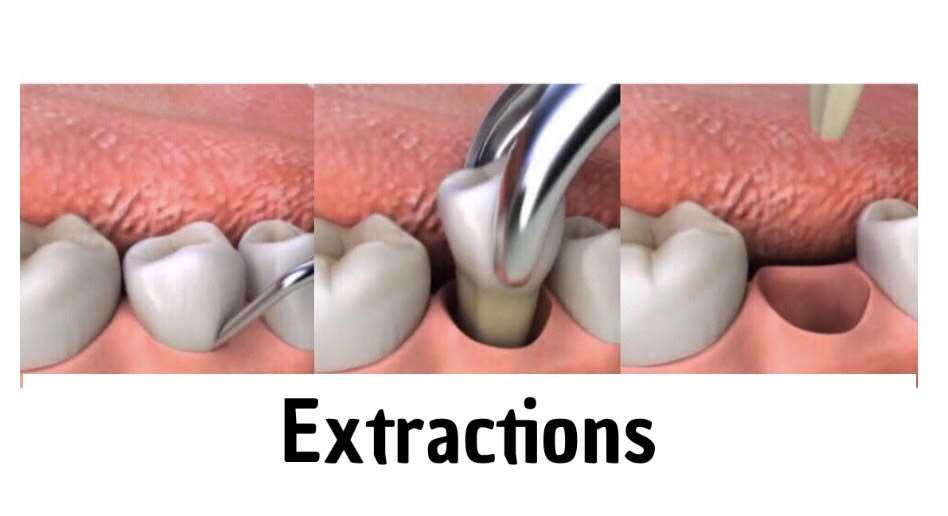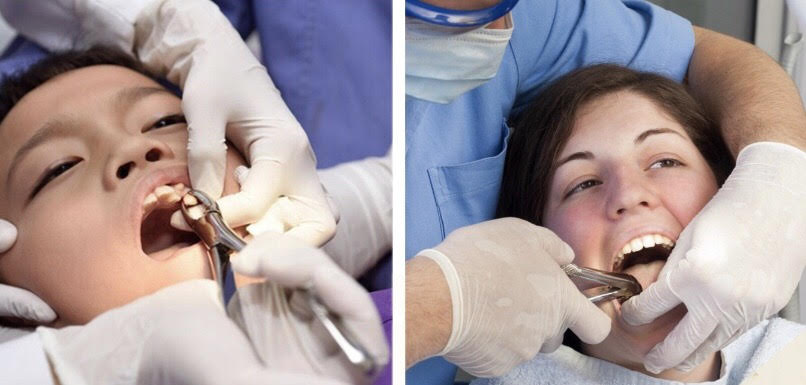- Navigation
- OUR OFFICE
- » MEET OUR DOCTOR
- » MEET OUR STAFF
- » OFFICE TOUR & INFORMATION
- SERVICES
- » FIRST OFFICE VISITS
- » CHILDREN DENTAL CARE
- » PREVENTATIVE CARE
- » COMPOSITE FILLINGS
- » PERIODONTAL
- » ROOT CANAL THERAPY
- » CROWN & BRIDGE
- » EXTRACTIONS
- » DENTURES
- » IMPLANT DENTISTRY
- » WHITENING
- PAYMENTS
- » INSURANCE
- » FINANCING
- » SCHEDULING
- » DENTAL EMERGENCIES
- » SPECIAL OFFERS
- NEW PATIENT
- CONTACT
What Is an Extraction?
Tooth extraction is the removal of a tooth from its socket in the bone.
What It's Used For
If a tooth has been broken or damaged by decay, your dentist will try to fix it with a filling, crown or other treatment. Sometimes, though, there's too much damage for the tooth to be repaired. In this case, the tooth needs to be extracted. A very loose tooth also will require extraction if it can't be saved, even with bone replacement surgery (bone graft).
Here are other reasons:
- Some people have extra teeth that block other teeth from coming in.
- Sometimes baby teeth don't fall out in time to allow the permanent teeth to come in.
- People getting braces may need teeth extracted to create room for the teeth that are being moved into place.
- Some teeth may need to be extracted if they could become a source of infection after an organ transplant. People with organ transplants have a high risk of infection because they must take drugs that decrease or suppress the immune system.
- Wisdom teeth, also called third molars, are often extracted either before or after they come in. They commonly come in during the late teens or early 20s. They need to be removed if they are decayed, cause pain or have a cyst or infection. These teeth often get stuck in the jaw (impacted) and do not come in. This can irritate the gum, causing pain and swelling. In this case, the tooth must be removed. If you need all four wisdom teeth removed, they are usually taken out at the same time.
Preparation
Your dentist or oral surgeon will take an X-ray of the area to help plan the best way to remove the tooth. Be sure to provide your full medical and dental history and a list of all medicines you take. This should include both prescription and over-the-counter drugs, vitamins and supplements.
If you are having wisdom teeth removed, you may have a panoramic X-ray. This X-ray takes a picture of all of your teeth at once. It can show several things that help to guide an extraction:
- The relationship of your wisdom teeth to your other teeth
- The upper teeth's relationship to your sinuses
- The lower teeth's relationship to a nerve in the jawbone that gives feeling to your lower jaw, lower teeth, lower lip and chin. This nerve is called the inferior alveolar nerve.
- Any infections, tumors or bone disease that may be present
Some doctors prescribe antibiotics to be taken before and after surgery. This practice varies by the dentist or oral surgeon. Antibiotics are more likely to be given if:
- You have an infection at the time of surgery
- You have a weakened immune system
- You will have a long surgery
- You have specific medical conditions
Do not smoke on the day of surgery. This can increase the risk of a painful problem called dry socket.
After the extraction, someone will need to drive you home and stay there with you. You will be given post-surgery instructions. It is very important that you follow them.
How It's Done
There are two types of extractions:
- A simple extraction is performed on a tooth that can be seen in the mouth. General dentists commonly do simple extractions. In a simple extraction, the dentist loosens the tooth with an instrument called an elevator. Then the dentist uses an instrument called a forceps to remove the tooth.
- A surgical extraction is a more complex procedure. It is used if a tooth may have broken off at the gum line or has not come into the mouth yet. Surgical extractions commonly are done by oral surgeons. However, they are also done by general dentists. The doctor makes a small incision (cut) into your gum. Sometimes it's necessary to remove some of the bone around the tooth or to cut the tooth in half in order to extract it.
Most simple extractions can be done using just an injection (a local anesthetic). You may or may not receive drugs to help you relax. For a surgical extraction, you will receive a local anesthetic, and you may also have anesthesia through a vein (intravenous). Some people may need general anesthesia. They include patients with specific medical or behavioral conditions and young children.
During a tooth extraction, you can expect to feel pressure, but no pain. If you feel any pain or pinching, tell your doctor.
Follow-Up
Your doctor will give you detailed instructions on what to do and what to expect after your surgery. If you have any questions, make sure to ask them before you leave the office.
Having a tooth taken out is surgery. You can expect some discomfort after even simple extractions. Usually it is mild. Research has shown that taking nonsteroidal anti-inflammatory drugs (NSAIDs) can greatly decrease pain after a tooth extraction. These drugs include ibuprofen, such as Advil, Motrin and others. Take the dose your doctor recommends, 3 to 4 times a day. Take the first pills before the local anesthesia wears off. Continue taking them for 3 days. Ask your doctor for complete instructions.
Surgical extractions generally cause more pain after the procedure than simple extractions. The level of discomfort and how long it lasts will depend on how difficult it was to remove the tooth. Your dentist may prescribe pain medicine for a few days and then suggest an NSAID. Most pain disappears after a couple of days.
A cut in the mouth tends to bleed more than a cut on the skin because it cannot dry out and form a scab. After an extraction, you'll be asked to bite on a piece of gauze for 20 to 30 minutes. This pressure will allow the blood to clot. You will still have a small amount of bleeding for the next 24 hours or so. It should taper off after that. Don't disturb the clot that forms on the wound.
You can put ice packs on your face to reduce swelling. Typically, they are left on for 20 minutes at a time and removed for 20 minutes. If your jaw is sore and stiff after the swelling goes away, try warm compresses.
Eat soft and cool foods for a few days. Then try other food as you feel comfortable.
A gentle rinse with warm salt water, started 24 hours after the surgery, can help to keep the area clean. Use one-half teaspoon of salt in a cup of water. Most swelling and bleeding end within a day or two after the surgery. Initial healing takes at least two weeks.
© 2012-2017 HQNguyen.com, All Rights Reserved. Designed by Web Tech Enterprise, LLC.


